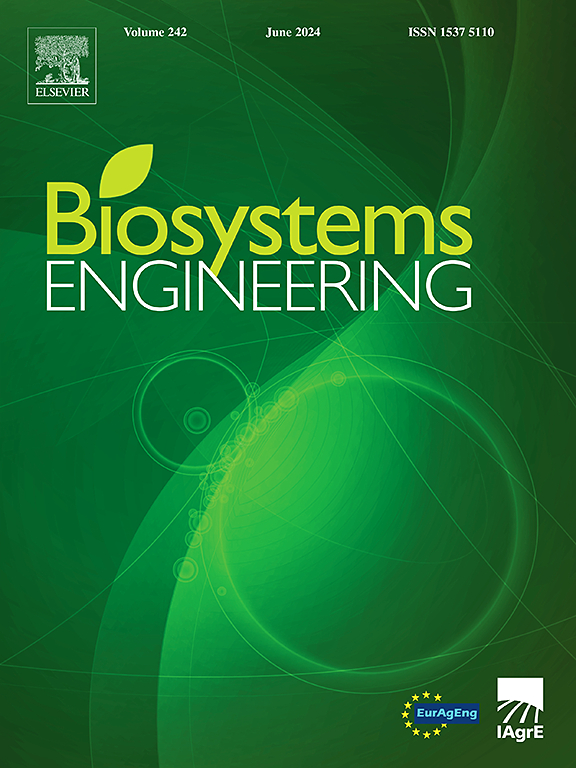考虑非饱和带的修正Green-Ampt模型的发展
IF 5.3
1区 农林科学
Q1 AGRICULTURAL ENGINEERING
引用次数: 0
摘要
Green-Ampt (GA)模型被广泛用于估算土壤水分入渗。然而,矩形饱和活塞流模型的假设限制了其准确表示实际入渗过程的能力。本文建立了考虑入渗过程中非饱和带的改进的Green-Ampt (MGA)模型。该模型假定非饱和区土壤含水量呈椭圆型分布,平均非饱和导水率等于平均土壤含水量所对应的导水率。给出了润湿锋面平均吸头的合理修正项。结果表明,非饱和区与润湿锋的厚度比呈非线性减小。利用HYDRUS-1D对美国农业部12种土壤质地进行了室内试验和一维垂直入渗模拟,验证了MGA模型的有效性。计算平均绝对误差(MAE)、平均相对误差(MRE)和百分比偏差(PB)值来评估模型的性能。MGA模型估算的湿润锋平均MAE、MRE和PB值与HYDRUS-1D的实测值和模拟值的平均值分别为8.8 mm、6.6%、- 2.7%和20.6 mm、6.4%、- 4.3%。累积入渗的平均MAE、MRE和PB值分别为2.7 mm、5.9%、−3.9%和2.1 mm、4.0%、−1.6%。MGA模型的估计误差小于GA模型,表明MGA模型对一维垂直入渗有较准确的估计,适用于多种土壤质地。本文章由计算机程序翻译,如有差异,请以英文原文为准。
Development of a modified Green–Ampt model considering the unsaturated zone
The Green–Ampt (GA) model is widely used for estimating water infiltration in soil. However, the assumptions of a rectangular saturated piston flow model limit its capacity to accurately represent the actual infiltration process. This study developed a modified Green–Ampt (MGA) model that considers the unsaturated zone during infiltration. This model assumes an elliptical distribution for the soil water content in the unsaturated zone and the average unsaturated hydraulic conductivity is equal to that corresponding to the average soil water content. It also offers a reasonable correction term for the average suction head at the wetting front. Results indicate a nonlinear decrease in the thickness ratio of the unsaturated zone to the wetting front. Validation of the MGA model was conducted using laboratory experiments and one-dimensional vertical infiltration simulation for 12 USDA soil textural classes by HYDRUS-1D. Mean absolute error (MAE), mean relative error (MRE), and percentage bias (PB) values were calculated to evaluate model performance. The average MAE, MRE and PB values between the estimated wetting front by MGA model with the measured and simulated values by HYDRUS-1D are 8.8 mm, 6.6 %, −2.7 %, and 20.6 mm, 6.4 %, −4.3 %, respectively. And the average MAE, MRE and PB values for the cumulative infiltration are 2.7 mm, 5.9 %, −3.9 %, and 2.1 mm, 4.0 %, −1.6 %, respectively. The estimated errors of the MGA model were lower than those of the GA model, indicating that the MGA model provides accurate estimates for one-dimensional vertical infiltration and is suitable for a variety of soil textures.
求助全文
通过发布文献求助,成功后即可免费获取论文全文。
去求助
来源期刊

Biosystems Engineering
农林科学-农业工程
CiteScore
10.60
自引率
7.80%
发文量
239
审稿时长
53 days
期刊介绍:
Biosystems Engineering publishes research in engineering and the physical sciences that represent advances in understanding or modelling of the performance of biological systems for sustainable developments in land use and the environment, agriculture and amenity, bioproduction processes and the food chain. The subject matter of the journal reflects the wide range and interdisciplinary nature of research in engineering for biological systems.
 求助内容:
求助内容: 应助结果提醒方式:
应助结果提醒方式:


